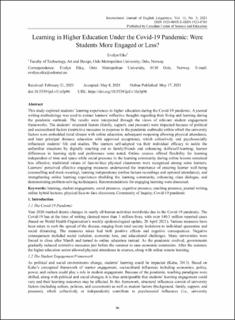| dc.contributor.author | Eika, Evelyn | |
| dc.date.accessioned | 2021-06-04T09:13:49Z | |
| dc.date.available | 2021-06-04T09:13:49Z | |
| dc.date.created | 2021-05-27T10:33:19Z | |
| dc.date.issued | 2021-05-17 | |
| dc.identifier.citation | International Journal of English Linguistics. 2021, 11 (3), 96-120). | en_US |
| dc.identifier.issn | 1923-869X | |
| dc.identifier.uri | https://hdl.handle.net/11250/2757657 | |
| dc.description.abstract | This study explored students’ learning experiences in higher education during the Covid-19 pandemic. A journal writing methodology was used to extract learners’ reflective thoughts regarding their living and learning during the pandemic outbreak. The results were interpreted through the views of relevant student engagement frameworks. The students’ structural factors (family, support, and pressure) were impacted because of political and sociocultural factors (restrictive measures in response to the pandemic outbreak) within which the university factors were embedded (total closure with online education, subsequent reopening allowing physical attendance, and later principal distance education with approved exceptions), which collectively and psychosocially influenced students’ life and studies. The learners self-adapted via their individual efficacy to tackle the unfamiliar situations by digitally reaching out to family/friends and enhancing skills/self-learning; learner differences in learning style and preferences were noted. Online courses offered flexibility for learning independent of time and space while social presence in the learning community during online lessons remained less effective; traditional values of face-to-face physical classrooms were recognised among some learners. Learners’ perceived effective engaging measures underscored the importance of ensuring learner well-being (counselling and mask-wearing), learning independence (online lecture recordings and optional attendance), and strengthening online learning experiences (building the learning community, enhancing class dialogue, and demonstrating problem-solving techniques). Recommendations for engaging learning were discussed. | en_US |
| dc.language.iso | eng | en_US |
| dc.publisher | Canadian Center of Science and Education | en_US |
| dc.relation.ispartofseries | International Journal of English Linguistics;volume 11, issue 3 | |
| dc.rights | Navngivelse 4.0 Internasjonal | * |
| dc.rights.uri | http://creativecommons.org/licenses/by/4.0/deed.no | * |
| dc.subject | Learning | en_US |
| dc.subject | Student engagements | en_US |
| dc.subject | Social presences | en_US |
| dc.subject | Cognitive presences | en_US |
| dc.subject | Teaching presences | en_US |
| dc.subject | Journal writings | en_US |
| dc.subject | Online hybrid lectures | en_US |
| dc.title | Learning in Higher Education Under the Covid-19 Pandemic: Were Students More Engaged or Less? | en_US |
| dc.type | Peer reviewed | en_US |
| dc.type | Journal article | en_US |
| dc.description.version | publishedVersion | en_US |
| dc.rights.holder | By the author. | en_US |
| cristin.ispublished | true | |
| cristin.fulltext | original | |
| cristin.qualitycode | 0 | |
| dc.identifier.doi | https://doi.org/10.5539/ijel.v11n3p96 | |
| dc.identifier.cristin | 1912163 | |
| dc.source.journal | International Journal of English Linguistics | en_US |
| dc.source.volume | 11 | en_US |
| dc.source.issue | 3 | en_US |
| dc.source.pagenumber | 96-120 | en_US |

